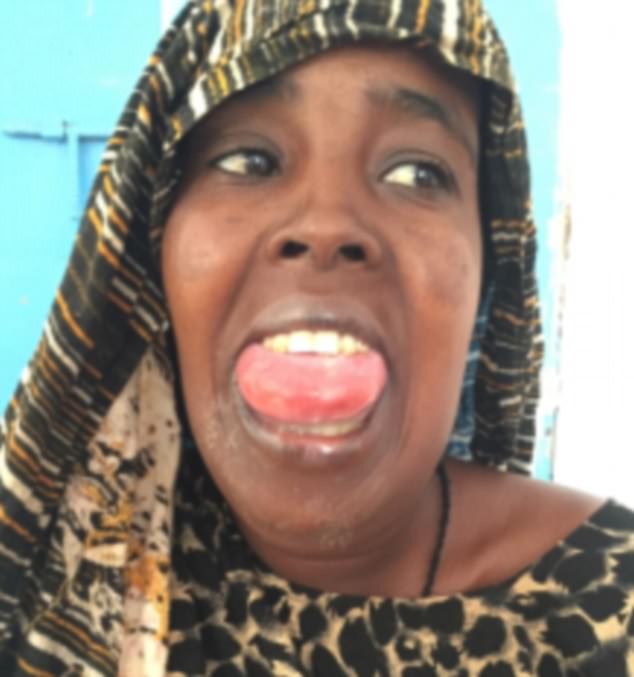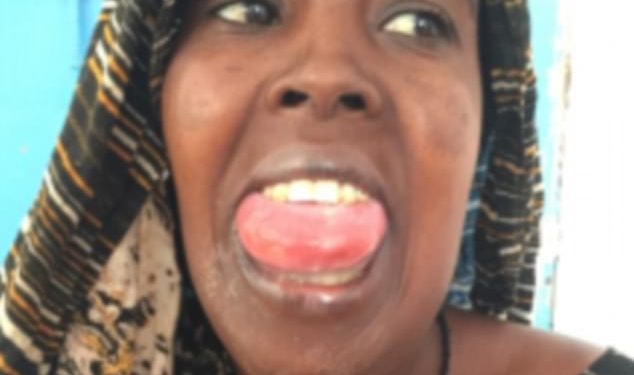Surviving a bite from a viper is rare.
Regarded as one the world’s deadliest snakes, a lunge from a viper can cause intense pain, convulsions, nausea, and even paralysis, followed by death.
But one Ethiopian woman found herself lucky to escape alive after being bitten by one as she slept, shrugging it off as a dry bite.
She did not seek medical attention, however just three days later, was left fighting for breath after her throat and tongue swelled up rapidly.
In a case that has baffled doctors, the 20-year-old was rushed to hospital where she was eventually told she had caught a bacterial infection from the snake’s mouth.
The unnamed woman, from Ethiopia, was diagnosed with Ludwig’s angina, which makes the sufferer feel like they are being choked or strangled.
It is highly unusual following a snake bite, according to an article published in BMJ Case Reports.

Doctors were baffled
A quarter of a million people die every year with as a result of encounters with snakes such as vipers, cobras or kraits mainly because of their toxic venom.
Some types of vipers can strike at a speed of a quarter of a second – their long, hinged fangs act like a needle injecting a deep shot of poison into their prey.
The woman was therefore extremely lucky to not have been poisoned – especially since there was no antivenom even available at the small emergency department of Degehbur Hospital in the Somali region.
Ludwig angina was first described by Karl Friedrich Wilhelm von Ludwig in 1836.
It can develop after an infection of the roots of the teeth (such as tooth abscess) or a mouth injury.
The infected area swells quickly and may block airways.
Other symptoms include: difficulty swallowing, drooling, unusual speech, tongue swelling or protrusion of the tongue out of the mouth, fever, neck pain and neck swelling.
Patients may also have weakness, fatigue, confusion or other mental changes and earache.
The condition is exceptionally rare nowadays as a result of widely available antibiotics therapy and advances in medical and surgical care.
At first, doctors were did not know exactly what was causing her symptoms – including a high temperature and difficulty in swallowing – three days after the bite.
After being given steroids and antibiotics for 30 minutes with no improvement, they were ready to rush her to a hospital four hours away for a tracheostomy, an opening in her neck to insert a tube into the windpipe to help her breathe.
But the patient refused the intervention and began to respond to the drugs. She was discharged 10 days later.
Unusual reaction
Without intervention, patients with Ludwig’s angina have a 50 per cent chance of survival, the report notes.
When a viper bite doesn’t kill, local complications can include pain, death of the surrounding tissue and cellulitis, an infection of the deeper layers of skin.
Ludwig’s Angina, which is a skin infection under the tongue which can rapid lead to airway compromise and death, is an unusual reaction to a snake bite, the doctors note.
‘Contamination from oral flora of the snake could cause secondary wound infection,’ they said.
‘In this case, secondary infection would cause severe soft tissue inflammation and swelling of the neck and later on it would progress to Ludwig’s angina.’
Woman bitten by a viper survives the snake's deadly venom
0
Leave a Reply Cancel reply
BROWSE BY CATEGORIES
- #SmartLagos
- Basketball
- Beauty
- Boxing
- Breaking
- Business
- Careers
- Crime
- Default
- Education
- Entertainment
- Event
- Fashion
- Featured
- Football
- Gaming
- Gist
- Golf
- Health
- Inspirational Patience
- Interview
- Investigative
- Law
- Lifestyle
- local
- MetroMan
- MetroPerson
- metroplus
- MetroProfile
- Movies
- Music
- MUSIC
- New Music
- News
- nolly wood
- Nollywood
- Novels
- Odawood
- Opinion
- Parenting
- Photos
- Politics
- Press Release
- Relationship
- Religion
- Scandal
- Security
- Sex
- Society
- Sports
- Technology
- Travel
- TV
- Videos
- Weird
- Wheels
- World
BROWSE BY TOPICS
#COVID19Nigeria
#EndSARS
Adams Oshiomhole
Akinwunmi Ambode
APC
ASUU
atiku
Atiku Abubakar
Big brother Naija 2020
boko haram
Buhari
Bukola Saraki
CBN
court
COVID-19
davido
ECOWAS
Edo Election
Edo State Election
efcc
Featured
FG
Goodluck Jonathan
gunmen
INEC
Kayode Fayemi
Lagos
Lagos State
Muhammadu Buhari
NCDC
NDLEA
news
Niger
Nigeria
NLC
Obaseki
PDP
police
politics
President Buhari
Sanwo Olu
senate
tinubu
wike
Yemi Osinbajo
© Copyright MetroNews NG 2020. All rights reserved.









